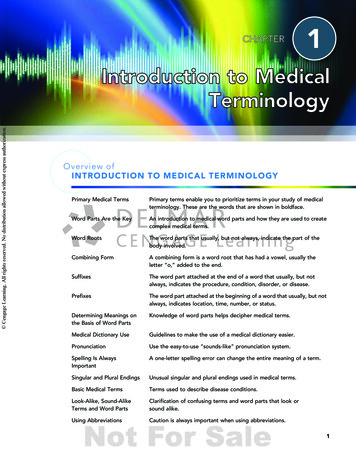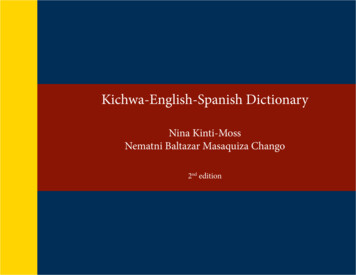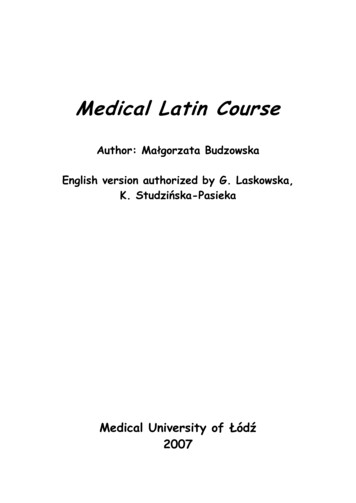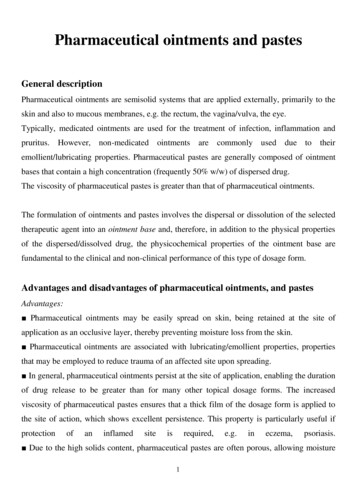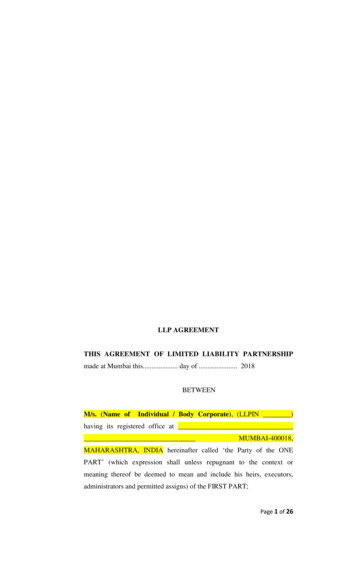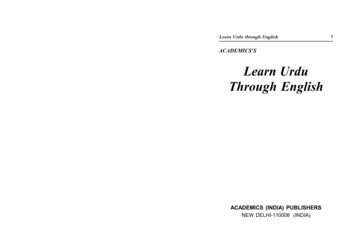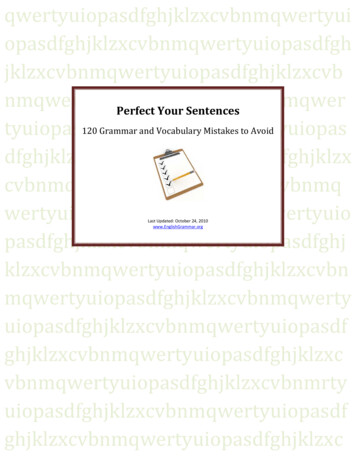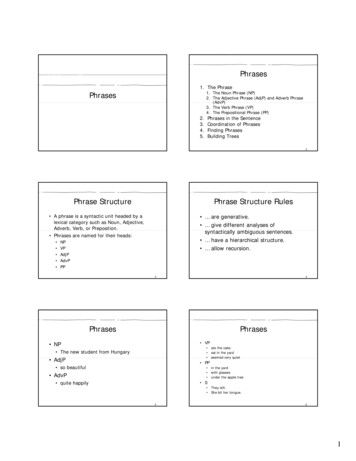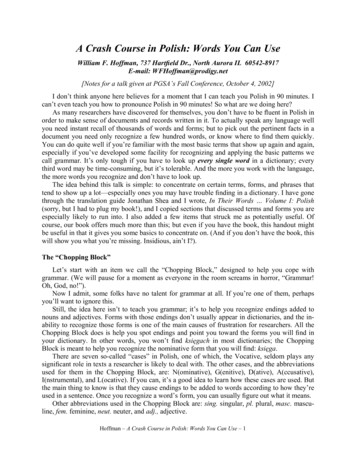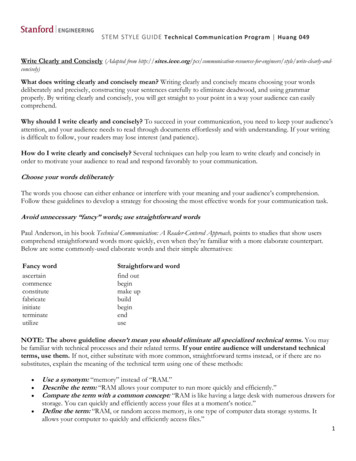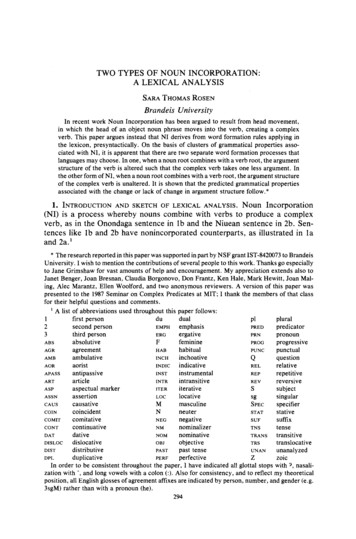
Transcription
TWO TYPES OF NOUN INCORPORATION:A LEXICAL ANALYSISSARA THOMAS ROSENBrandeis UniversityIn recent work Noun Incorporationhas been arguedto result from head movement,in which the head of an object noun phrase moves into the verb, creatinga complexverb. This paperarguesinstead that NI derives from word formationrules applyinginthe lexicon, presyntactically.On the basis of clusters of grammaticalpropertiesassociated with NI, it is apparentthat there are two separatewordformationprocesses thatlanguagesmaychoose. In one, whena nounrootcombineswitha verbroot, the argumentstructureof the verb is alteredsuch that the complex verb takes one less argument.Inthe otherformof NI, whena nounroot combineswitha verbroot, the argumentstructureof the complex verb is unaltered.It is shown that the predictedgrammaticalpropertiesassociated with the changeor lack of changein argumentstructurefollow.*1. INTRODUCTIONANDSKETCHOF LEXICALANALYSIS.Noun Incorporation(NI) is a process whereby nouns combine with verbs to produce a complexverb, as in the Onondagasentence in Ib and the Niuean sentence in 2b. Sentences like Ib and 2b have nonincorporatedcounterparts,as illustratedin laand 2a.'* The researchreportedin thispaperwas supportedin partby NSF grantIST-8420073to BrandeisUniversity.I wish to mentionthe contributionsof severalpeopleto this work.Thanksgo especiallyto Jane Grimshawfor vast amountsof help and encouragement.My appreciationextends also toJanetBenger,JoanBresnan,ClaudiaBorgonovo,Don Frantz,Ken Hale, MarkHewitt, JoanMaling, Alec Marantz,Ellen Woolford,and two anonymousreviewers. A version of this paperwaspresentedto the 1987Seminaron ComplexPredicatesat MIT;I thankthe membersof that classfor their helpfulquestionsand comments.A list of abbreviationsused throughoutthis paperfollows:1first persondudualpiplural23ABSAGRsecond personthird SSantipassiveARTarticleASPaspectual TcomitativeCONTcontinuativeDATdativeDISLOC euternegativenominalizernominativeobjectivepast cativeunanalyzedzoicIn orderto be consistentthroughoutthe paper, I have indicatedal glottal stops with ?, nasalization with ', and long vowels with a colon (:). Also for consistency, and to reflect my theoreticalposition, all Englishglosses of agreementaffixesare indicatedby person,number,andgender(e.g.3sgM)ratherthan with a pronoun(he).294
TWO TYPES OF NOUN INCORPORATION295(1) Onondaga(Woodbury1975:10)a. wa hahninu?iTNS.3Sg.3N.buy.ASPne ? oykwa ?.ART 3N.tobacco.NM'He bought the tobacco.'b. wa 2haye kwahni:nu?,TNS.3sg.3N.tobacco.buy.ASP'He bought tobacco.(2) Niuean (Seiter 1980:69)a. Takafaga tu:mau ni: eia e tau ika.2huntalways EMPHERGhe ABS PL fish'He's always huntingfish.' ( He's always fishing)b. Takafaga ika tu:mau ni: a ia.huntfish always EMPHABS he'He's always fish-hunting.'( He's always fishing.)It has been suggested, most notably by Sadock 1980, 1985a, 1986 and byBaker (1988a:Ch.3), that noun incorporationis a syntactic rule that realizesthe head of the direct object noun phrase or the head of the subject of anunaccusative verb within the verbal complex, either by movement (Baker)orby coanalysis (Sadock). The result is a morphologicallycomplex verb, containinga noun root that is linked to the direct object position (eitherby a tracerelation or by the disjunctionof the syntactic and morphologicalanalyses). Inlb and 2b, the verbs, which are ordinarilytransitive, have no overt directobject. Examples of NI out of the subjectof an unaccusativeverb are in 6 and7. An alternativeto the syntactic approachto NI is to posit that the complexverb is derivedlexically, by a word-formationprocess similarto compounding.Mithun 1984, 1986aand Di Sciullo & Williams(1987:64-68) suggest that NI isa lexical process. The researchreportedin the currentpaper supportsa lexicalanalysis of NI, but goes beyond the syntactic/lexicaldistinctionto show thatthere are two distinct types of NI.3 This paperexplores the grammaticalproperties associated with noun incorporation,showing that they follow directlyfrom a lexical analysis that distinguishestwo differentcases of NI.In this theory, there are two kinds of NI representedacross languages.Oneis like simple compounding,similarto compoundingin English. In this formof NI, when a noun and verb combine to form a complex verb, one argumentof the simple verb is satisfied within the verb.4 Thus, if a simple verb takes2The ergative/absolutivecase markersin Niueanhave a differentphonologicalform dependingon whetherthe noun is a commonnoun, or a pronounor propernoun (Seiter 1980):COMMON NOUNPROPER-/PRONOUNheeABSOLUTIVEae3Mithun 1984delineatedfour types of NI based on four distinct discoursefunctions of incorporation,includingcompoundand classificatoryfunctions,and also arguedfor a lexical approachto NI. The reasoningused to arguefor the two types of NI in my theory is purelysyntactic andnot discourse/functional.4 The few Englishverbalcompoundsthatexist maynotresultin an intransitiveverb(e.g. babysit).However, these are clearlybackformationsfrom noun compounds,and are completelyunproductive (Selkirk 1983:16-17,Mithun1984).ERGATIVE
296LANGUAGE,VOLUME65, NUMBER 2 (1989)two arguments, (x, y), the N V complex takes only one: (x), an externalargument.The verb is then intransitive.I will call this CompoundNI. Compound NI affects the argumentstructureof the simple, non-compoundedformof a verb, as illustratedin the Niuean sentences in 2a-b.In other languages, when the object incorporatesinto the verb, the verb'stransitivityis completely unaffected, which makes it look quite differentfromcompounding.In this form of NI, unlike in CompoundNI, the incorporatednoun does not satisfy an argumentof the verb. If the simpleverb takes a directobject argument,then the complex verb also co-occurs with a direct objectNP, which is requiredto satisfythe verb's argumentstructure.The directobjectargumentand the incorporatednoun are linked semanticallyin much the sameway that a noun classifier is linked semanticallyto the noun it classifies. I callthis ClassifierNI, because the incorporatednoun acts like a classifier on thenoun it is associated with; the reasons for this will become clear in a latersection.When one explores the data on NI, one finds that those languagesthat haveClassifierNI also allow whatis commonlycalled 'stranding',a process wherebyan NP modifieris left with no head noun, while a noun with the same semanticreference is incorporatedinto the verb. I refer to the strandeditems as 'nullhead modifiers',because they modifythe head noun, which is null. As arguedin a later section, the range of strandingfacts in these languagesfollows froman interactionbetween NI and an independentprocess in the languages-theexistence of null head modifiers.The division of NI into the two types arguedfor here is supportedby thesyntacticbehaviorof NI, specificallythe identificationof a clusterof propertiesassociated with it. Furthersupportfor this distinctioncomes from the functionof NI as expounded in Mithun 1984. Mithundelineatedfour differenttypes ofNI on a functionalor discourse basis. Her first three functionalcategories ofNI correspondto my CompoundNI, and her fourth correspondsto my Classifier NI. Mithun'sclassificationlends functionalcredence to the division proposed here purely on grammaticalgrounds.For ease of exposition, a list of languagesthat have Classifierand CompoundNI is given in Table 1. I will refer to these languages throughoutthe paper.This is not an exhaustive list of incorporatinglanguages;it contains the languages covered in the n IroquoianPolynesianMohawk, Seneca, Oneida,Samoan, Tongan, NiueanMicronesianOnondaga, Cayuga, TuscaroraCaddoMokilese, Ponapean, KusaieanRembarngaTABLE1. Incorporating languages discussed in this paper.The hypothesis that there are two kinds of NI leads to predictionsabout thegrammaticalpropertiesone should find associated with incorporation.Theseproperties include the effects on the transitivityof the verb, the ability of determiners and modifiers to appear without a head noun (commonly calledstranding),and the co-occurrenceof the complex verb with full NPs in direct
TWOTYPES OF NOUN INCORPORATION297object position (doubling).In the following sections of this paper, I show thatincorporatinglanguagesdisplayclusters of grammaticalpropertiesas predictedby Classifierand CompoundNI structures.I also discuss two alternativesyntactic approachesto noun incorporation-syntactic movementand autolexicalsyntax-and show that neither one predicts the grammaticalproperties thatthese languagesdisplay. In its totality, this paper shows that the identificationof the two independenttypes of NI, within a lexical account, captures theoverall propertiesof the constructionsthat occur.2. CLASSIFIERNI. An example of Classifier noun incorporationwas givenin 1. The nameClassifierNI was given because the incorporatednoun is similarto a classifier in that the object noun phrase, if overt, must be more specificthan (or, in some languages,at least as specific as) the incorporatednoun (seeWoodbury1975,for example);thus, it wouldbe impossibleto say 'I dog-boughtan animal' in Iroquoian.The equivalentof 'I animal-boughta dog' is fine, asis 'I animal-boughta large (animal)'(Janet Benger, personal communication1986).In ClassifierNI, the directobjectargumentis not satisfiedwithinthe complexverb, and thereforean object NP must co-occur with NI to satisfy the verb'sargumentstructure.However, the incorporatednoun places a selectional restrictionon the verb, such thatthe objectNP mustbe withinthe class of objectsdelineated by the incorporatednoun root. This explains the fact noted aboveconcerning the specificity requirementon the NP associated with the incorporated noun. Thus, the equivalentof 'I animal-boughta dog' is fine because'dog' is within the class delineated by the incorporatednoun 'animal'. Thesame is true for 'I animal-boughta large (animal)'.However, in 'I dog-boughtan animal', animal is not included in the class of items that are 'dogs'. Thelatter sentence would be judged ungrammaticalbecause the selectionalrestrictions placed on the verb are not met. Therefore, the claim is that the onlyargumentstructureeffect of Classifier NI is the extra selectional restrictionplaced on the verb.The range of possible direct object NPs following an incorporatednoun areillustratedin the diagrams3a-c. The NP can be completely empty (3a), as inpro-drop;the N or N' can be empty (3b), commonlyreferredto as 'stranding';or the entire NP can be filled, often called 'doubling'.5(3) ClassifierNIa. Empty NPb. StrandingVPVI[N V]VPNPI0VI[N V]NPSpecN'05 Some of the argumentsexpoundedin this section were independentlymade in Di Sciullo &Williams(1987:63-68). In particular,they noticed the independentwell-formednessof strandedmodifiers,and they also point to the doublingfacts.
298LANGUAGE, VOLUME 65, NUMBER 2 (1989)c.DoublingVPNPV[N V]N'SpecN{PP}ICPJOne importantfact about all of the Classifierincorporatinglanguagesis thatthey all freely allow pro-dropin all positions. Pro-dropin Onondagais illustrated below:(4) Onondaga(Mithun& Woodbury1980:62)ka-Ruhi-a2-ke he-i tru-2. shukw-ateen-o l-STATwa 2-ha-u-?[pro][pro].AOR-M . M-give-PUNC'He who createdus and lives in the sky gave him (this knowledge).'I have added [pro]twice at the end of sentence 4 to indicateempty pronominalelements (linearposition irrelevant).The 'knowledge' mentionedin the translation of 4 is inferredfrom earlier discourse, and is therefore understood asthe theme of 'give'. The goal understoodas 'him' is apparentfrom the agreement markeron the verb.62.1. STRANDINGOFMODIFIERSANDNULLPRO-FORMS.In Classifier NI, incor-porated nouns can be associated with NPs that have determiners,modifiers,and possessors, but no head noun. This is called 'stranding'in the literature,and it arises when the direct object NP is partly null (as diagrammedin 3b).The stranded element modifies the null head of the direct object NP. Thepresent theory attributesthe strandingfacts to an independentphenomenoninthe language (the existence of null-headmodifiers in general). An inevitableconsequence of a languagewith the two properties-NI and null pro-formsis that the two will interact, and indeed they do.The direct object NP in a clause with an incorporatednoun appearsjust likeany NP in the language. If the form of the NP is truly independentof theincorporatednoun, then null-headmodifiers(often called strandedmodifiers)shouldbe possible whethera nounis incorporatedor not. The analysisassumes6 Some Iroquoianists analyze the agreement markers as the argumentsof the verb, with the NPsexternal to the verb complex serving as adjuncts that may double the arguments (Mithun 1986b,for example). Notice, however, that if the agreement morphemes are the arguments, then one mightbe forced to say that a verb like 'give' in 4 has only two arguments, the agent and goal; the themewould not be an argument, because it does not appear as a prefix on the verb. Because of thevarious problems with the hypothesis that the agreement morphemes are actually the arguments,I will refer to such constructions as pro-drop, meaning that the verbal prefixes are simply agreementprefixes, and the actual arguments are outside the verb, with pro-drop applying freely. It shouldbe noted, however, that the terms used to refer to the verbal prefixes and the independent NPsmake no difference for the theory put forth in this paper.
TWOTYPES OF NOUN INCORPORATION299that null objects are independentof NI, and thus null-headmodifiers shouldoccur independentof NI. The crucialevidence for such independencerequiresa sentence with a simple transitive verb, and a direct object NP with a nullhead. Mithun1984presents evidence for null heads of NPs in Mohawk. In 5a,the theme/patient'dress' is incorporated,the head of the object NP is empty,and the modifier'dotted' is stranded.In 5b, however, the modifier'dotted' isagain left stranded,but this time the head N does not appearin the sentenceat all, and there is no incorporatednoun.(5) Mohawk (Mithun1984:870)a. Kanekwarunyu wa 2-k-akya?tawiPtsher-u:ni.3N.dotted.DiST PAST-1sg.3N-dress-make7'I made a polka-dotteddress.'b. Kanekwarunyu wa ?katkdhtho.3N.dotted.DIsT PAST.1sg.3N.see'I saw a dotted (one).'It is interestingto note that in 5b the adjective kanekwarunyu'dotted' agreesin gender (neuter)with a phonologicallynonexistent noun, and that the agreement patternis the same with and without incorporation.This presents strongevidence for a null N or N'; agreementis a function of the null position, andnot of an incorporatednoun.Furtherevidence of the syntactic independenceof the direct object and theincorporatednoun is illustratedin the strandingof demonstrativesand quantifiers in Caddo, anotherNative Americanlanguage.In 6a and 7a, a noun stemis incorporated,whereas in 6b and 7b no incorporationhas taken place. TheNPs are identical in the two sentences, indicatingthat the form of the NP (inparticular,the empty head) is not in any way dependentupon NI.(6) Caddo (Mithun1984:865-6)a. nd: kan-nuh-2a?.that water-run.out-will'That water will run out.'b. na: ?iyuh2a2.that run.out.will'That will run out.'(7) Caddo (Mithun1984:866)a. wayah hdk-k2uht-2iP-sa ?.a.lot PROG-grass-be.grow-PRoG'There is a lot of grass.'b. wayah hah- T2-sa ?.a.lot PROG-be.grow-PRoG'There is a lot.'7 Mithunglosses the agreementprefix -k- with only subject agreement.However, agreementwith a nonhumanobject is always realizedas 0 on the surface, and thereforewhen the object isnonhuman,transitiveagreementis identicalto intransitiveagreement(Postal 1979:140ff,Williams1976:170).Therefore,I have glossed the agreementin 5 as a transitiveprefix; explanationandevidence for this is providedin ?2.2.
300LANGUAGE,VOLUME65, NUMBER 2 (1989)To furtherestablishthe independentwell-formednessof null-headmodifiers,one must also look at NPs not ordinarilyassociated with NI. NI is said to beassociated with the direct object NP, or the subject of an unaccusative verb.However, in the Iroquoianand Caddoanlanguages any NP can have a nullhead. Examples of modifierstrandingin subject position and adjunctpositionare given in 8 and 9.(8) Tuscarora(Mithun& Woodbury1980:109)?a. . kye:ni:kv: ha2 kye ra-kwatihs 0 yah-wa-hra-kwa 2nthisthatthat M-young 0 TRS-AOR-M-sidea e:-2kye2 -hr-e2 ra-kwatihs 0thatREP-M-goM-young 0encircle-PuNchad gone around the other side, camewho'This young (man)back again as a young (man).'b. U:nv kye:ni:kv: 0 G-a-hr-ahr-ku-20 REP-AOR-M-gO-REV-PUNCnow thisyah-vB-a-hra-kwa n-aOe:- .8TRS-REP-AOR-M-side-encircle-PuNc'Now this (man)went back to where he came from.'(9) Seneca (Mithun& Woodbury1980:51)Ne:? waihneh hati-kowane-2s ne:? ka-ito-h,ne:2ASSN specifically the Mpl-big-HAB ASSN N-mean-HAB ASSN6.2 ne 2ho-owe-shohati-hsen-owane- 2s-kwaMpl-name-big-HAB-PASTthat-UNAN-PL'Big (ones) means that they were chiefs at that time.'Rembarnga,a NorthernAustralianlanguage, is an example of a ClassifierNI language that appears to have a restricted range of null-head modifiers.McKay 1975gives examples of null-headeddemonstrativesonly, as in 10.(10) Rembarnga(McKay 1975:120)walay ndnta-kanya-pa-wa.then that-DAT 3.0BJ. 1sg.TRANs.S-leave-PAsT.PUNc'so (then) because of that [fear]I left [shootingthe buffalo].'Ex. 11 shows that strandingdemonstrativesin NI constructionsis possible aswell. McKay gives no examples of strandingmodifiersother than demonstratives in NI constructions.(11) Rembarnga(McKay 1975:291)yar-kani-pete ?-mifndnta-0-ma.3sg.OBJ. lpl.TRANS. S-wounded-carry-PAST.puNC that-NOM-UNAN'We carriedthat wounded man.'It is possible that the demonstratives are actually nominalized (McKay refersto them as 'nominal demonstratives', and in this instance the demonstrativeappears to have a nominative case marker, used to mark objects and subjectsof ergative verbs). If lone demonstratives are nominalized, then it becomesclear that null-head modifiers do not exist in Rembarnga, and neither does8Mithun& Woodbury1980reportthe morphemekwa2n in 8b as kwa:nin their morphologicalanalysis, but as kwa?n elsewhere(includingthe runningtext of the same sentence). I have chosento use the form kwa?n to be consistent with theirother examples.
TWOTYPES OF NOUN INCORPORATION301stranding(as predictedby my theory). Ex. 11would then be a case of doubling,which will be shown in ?2.3 to be possible in Rembarnga.If one were to subscribeto a syntactic account of NI, strandingof modifiersin an NI constructionand the independentexistence of null-headedNPs wouldrequiretwo differentaccounts. In a syntactic account, the strandedmodifiersare created by the movement of the head out of the NP, thereby leaving themodifiers behind. Strandingis then directly tied to syntactically derived NI.However, in the lexical theory proposed here, null-headmodifiersin NI constructions and those independent of NI constructions both have the samesource.2.2. TRANSITIVITYOFTHEVERB.The incorporated noun does not satisfy anargumentof the verb, but is semanticallylinked to a direct object argument.Thus, it is predictedthat the complex verb in classifierNI constructionsshouldalways have the same numberof argumentswith and withoutNI. In the Northern Iroquoianlanguages,for example, the verb always agrees with its subject;when transitive, it also agrees with its object (Postal 1979for Mohawk).Whena noun is incorporatedinto the verb, the verb still has object agreement,evenwhen there is no overt direct object.The transitivityof a verb is often difficultto test in the NorthernIroquoianlanguages, because some of the transitiveagreementprefixes overlap with theintransitiveagreementprefixes. In particular,the prefixes on a transitiveverbwhen the object is zoic, neuter, and sometimes masculineare also intransitiveprefixes. This overlapis illustratedin the examplesin 12. Ex. 12ais an exampleof an intransitiveverb with the agreementmarkerho-, indicatinga thirdpersonmasculine subject.In 12bthe verb is transitive,and ho- is used again, this timeto indicatea thirdpersonmasculinesubjectand a thirdpersonmasculineobject.Ex. 12c is anotherexampleof a transitiveuse of ho-, but this time the argumentsare dropped (pro-drop).And finally, 12d provides an example of a transitiveverb with an incorporatednoun; again ho- is used (the agreement-3M.3Mis with 'pig' and not 'snout').(12) Mohawk(Mithun& Woodbury1980:84-85, 92)a. khnd:2a ne kwiskwis wa-t-ho-hA.:le-ht-e2.thenthe pigAOR-DPL-3M-yell-cAus-PuNc'Then the pig yelled.'b. khne ehlal yd:kA2wa-ho-hsel-e2ne ne kwiskwis.then dog they.say AOR-3M.3M-chase-PuNcthe the pig'Then the dog chased the pig.'c. kwah-oksaky-us-a-ho-tkd:wa-ht-e ?.very-immediately TRS-ITER-AoR-3M.3M-release-cAus-puNc'Immediatelyhe released him.'d. kwfskwis y-a 2-t-ho-2nyukwal-fhshta- ?.pigTRS-AOR-DPL-3M.3M-snout-grab-PuNc'He grabbedthe pig's nose.'In order to make a convincing argumentconcerning the transitivityof theverb in NI constructions,one must show that a transitiveagreementprefix cooccurs with noun incorporationwhen the object is not thirdpersonzoic, neuter,
302LANGUAGE,VOLUME65, NUMBER 2 (1989)or masculine, so that the prefix is distinct from the intransitiveprefixes. Sucha prefix is the Seneca agreementprefixshako-, which indicatesagreementwitha third person masculine subject and a third person feminine object. The examples in 13 show that when a noun is incorporatedinto the verb, the transitivity of the verb (as indicated by the 3M.3F agreementprefix shako-) isunaffected.(13) Seneca (Mithun& Woodbury1980:100)a. Ta:h o:neh nd:hda 2-a-shako-ke-2kyo ohand now CONTRASTIVEQUOTATIVENEG-AOR-3M.3F-See-PUNCkatka hoh, ne:? ky o6hneke nehke:sanywhere ASSNQUOTATIVErepeatedly this theye-ks-a 2a-:h.F-child-small-sTAT'And he didn't find the girl anywhere.'b. 0 2-shako-ya wa-ha-yake- 2-t.OUt-INCH-PUNCTRS-AOR-3M-take.'He went out to look for her.'Crucially, the agreementprefix in 13b is transitive.Transitivityis also unaffectedby NI in Rembarnga.Notice that, in the examples in 14, the incorporatednoun is semanticallyrelatedto the direct object;the direct object is phonologicallynull, but the agreementprefixes on the verbare transitive. (As pointed out to me by an anonymousreviewer, the ergativecase is used for all agentive subjects-transitive or intransitive-and thus cannot be used as a criterionfor transitivity.)(14) Rembarnga(McKay 1975:79). piri-rut-manin2-mijzmunaya-yiR.3sg. OBJ.3pl. TRANS. S. REL-road-build-PAST.PUNCwhite. man-ERG'. where the white men build a road.'The predictionof transitivityis borne out in NorthernIroquoianand in Rembarnga. There is no indicationin the literaturethat incorporationever affectsthe transitivityof the verb in these languages-a transitiveverb remainstransitive after NI has applied, and an intransitiveverb remains intransitiveafterNI has applied.2.3. DOUBLINGANDNI. One last prediction regarding classifier NI is that afull NP should be able to co-occur with a classifier. In fact, the languagesthathave a system of classifiers on the verb also have what is called doubling, inwhich there is an incorporatednoun in the verb, and the noun is repeated inthe directobject NP positionwith more specific (or, dependingon the language,at least as specific) information provided. This doubling phenomenon givesfurther evidence for the syntactic independence of NI and the direct object NPposition; it is an example of NI without a null element.Mithun 1984 describes doubling in some incorporating languages, showingthat the complex verb is sometimes accompanied by a more specific NP in the
TWOTYPES OF NOUN INCORPORATION303object position, as exemplifiedin 15 and 16 for Iroquoianand 17 for Caddoan.Notice that in each case in 15-17 the independentNP is more specific thanthe incorporatednoun, as requiredby the selectionalrestrictionsplaced on theverb by the incorporationprocess. For example, in 15 rabahbot 'bullhead'isa type of tsy 'fish', and in 17 kassi2 'bead' is perceptuallya type of 2icj 'eye'.(15) Mohawk(Mithun1984:870)Tohka niyohserd:ketsi nahe2 shate.:ku niku:ti rabahbotseveral so.it.year.numbersso it.goes eightwahu-tsy-ahni:nukiof.them bullheadrake ?niha.3M.3N-fish-boughtthis my.father9'Several years ago, my father bought eight bullheads.'(16) Tuscarora(Williams1976:60)ne-hra-taskw-ahkw-ha ?hadu-M-animal-pick.up-sERIALEMPHdogtsi:r.'He picks up domestic animals.' (He is a dog catcher.)(17) Caddo (Mithun1984:865)kassi hdh- kicd-sswi-sa 2.bead PROG-eye-string-PRoG'She is stringingbeads.'Finally, doublingis also attestedin Rembarnga.The only differencebetweendoublingin Iroquoianand Rembarngais that Rembarngadoes not requiremorespecific informationin the full NP.(18) Rembarnga(McKay 1975:296)par-kata?-ta-yi/i.kat,a? 03sg. OBJ. 3pl. TRANS. S-paperbarkstandpaperbark-NOM(CAUS)-PAST. CONT'They would spreadpaperbark(on the ground).'The morphologicalform of the doubled N may be different, as long as theincorporatednoun meets the selectional restrictionthat the NP be among theclass of items specified by the incorporatednoun. The morphologicalform ofthe incorporatednoun -tiuwa - in 19 is differentfrom that of the independentnoun kamunuLku?,thoughboth are interpretedas meaning'white ochre'. Notice that the selectionalrestrictionis still placed on the verb-the direct objectmust be at least as specific as the incorporatednoun. The restrictionis simplylooser in Rembarngathan it is in Iroquoianand Caddo.(19) Rembarnga(McKay 1975:296)kamunuyku ? 0ka-yi-yuwa 2-maji.10white.ochre-NoM3sg.INTR. S-coMIT-white.ochre-went'some white ochre arrived(i.e. bought by someone).'The examples of doublinghighlightthe lexical natureof ClassifierNI: there isno syntactic source for such doubled nouns. Further, there seem to be some9 In 15 Mithun1984glosses the agreementprefixwahu- as agreeingonly with the subject(3M).See n. 7 and ?2.2 for an explanationof the gloss given here.10The verbal agreementin this sentence is intransitivebecause the verb is unaccusative,withone (internal)argument.Incorporationin ergativeverbs is discussed more in ?5.
304LANGUAGE,VOLUME65, NUMBER 2 (1989)differencesin the requirementthatthe doubledNP be morelanguage-particularspecific thanthe incorporatednoun. It is possible thatthe selectionalrestrictionin IroquoianandCaddoaddsa requirementof specificityin additionto semanticcompatibility, whereas Rembarnga only requires semantic compatibility.Again, if one were to adopt a syntactic account of NI, there is no syntacticsource for the semantic restriction.2.4. SOUTHERNTIWAANDWESTGREENLANDICESKIMO.The analysis pre-sented above for ClassifierNI clearly predicts the grammaticalpropertiesassociated with NI in Iroquoian, Caddo, and Rembarnga. However, NI inSouthernTiwa and West Greenlandic1lis not quite as clear-cut. In this sectionI will outline the propertiesassociated with NI in these two languagesto showwhere they are similarto and differentfromIroquoian,Caddo,and Rembarnga,and finally I will mention a few possible solutions to the problems that theypresent.First, SouthernTiwa NI patternswith the ClassifierNI languagesin that NIdoes not affect the transitivityof the verb. Thus, it is evident that the processof NI does not affect the argumentstructureof the verb. Both the input andthe output of the word-formationrule is a transitive verb if the incorporatednoun is semanticallyrelated to the direct object. If the incorporatednoun isthe sole argumentof the verb (the subjects of unaccusativeverbs obligatorilyincorporate in Southern Tiwa when the subject argumentis inanimate), theverb still agrees with that one (internal)argument.The agreementprefixes andthe fact that transitivityis unaffectedby NI are illustratedin examples 20-22below.'2 In 20 and 21 the verb agrees with the direct object (which happens tobe null), and in 22 the verb agrees with the sole (subject) argumentof theunaccusative verb.13(20) SouthernTiwa (Allen et al. 1984:293)Te-shut-pe-ban.1sg.C-shirt-make-PAST'I made the shirts.'" West GreenlandicEskimois sometimesincludedin the literatureas a languagethat has NI.Because it allows stranding,it appears that it should be included as a classifier incorporatinglanguage.However, as Alana Johns (personalcommunication,1988)has pointedout to me, theevidence suggests that 'incorporation'in Eskimo is nothingat all like any of the incorporatinglanguagesdiscussed here. First, all verbs in Eskimoselect for whetherthey take noun roots; thusincorporationappliesonly obligatorily,andto a restrictedset of verbalaffixes. Incorporatingverbsin Eskimo mightbe better describedas verbalaffixes; the incorporatingverbs are not stems thatcan stand alone withouta noun. One mightfollow Sapir 1911and Mithun1986ain assumingthatEskimo does not have NI of the sort discussed here.12Because of the complexityof the informationencoded in the agreementprefixesof SouthernTiwa, I have used the glosses in Allen et al. 1984.The object agreementsystem in SouthernTiwaspecifies numberand animacyof the object. The agreementglosses referringto all thirdpersonsubjects and objects can be summarizedas follows (Allen et al. 1984):A-singular, animatenouns plus several inanimate(e.g. karude'car').B-plural, animateplus severalinanimate(as in A); singular,inanimateC-plural, inanimate13In ex. 22 NI is actuallyobligatory,because the subjectis inanimateand may not appearinsubjectposition.
TWOTYPES OF NOUN INCORPORATION305(21) SouthernTiwa (Allen et al. 1984:294)Seuanid
hunt always EMPH ERG he ABS PL fish 'He's always hunting fish.' ( He's always fishing) b. Takafaga ika tu:mau ni: a ia. hunt fish always EMPH ABS he 'He's always fish-hunting.' ( He's always fishing.) It has been suggested, most notably by Sadock 1980, 1985a, 1986 and by Baker (1988a:Ch.
